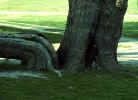On the WWW, images with no more than 256 colors are sent as palettized
images (usually .gif files), to reduce bandwidth and time for
downloading. If the image has more than 256 colors, it is usually sent as
a compressed .jpg file.

Example: Show the following image in different representations:


Pseudo-Color
Since the human eye is so limited in distinguishing shades of
gray, scientific data images are frequently pseudo-colored, with each data value
being assigned some color. Since the eye is very sensitive to color
changes, this allows subtle changes in the data to be more easily
discerned. For psychological reasons, specialized palettes are used that
have a natural interpretation of less-to-more, as for instance from blue to red,
indicating increasing temperature. In general, of course, there is no
natural way to specify one color as "more" than another.
Last modified on February 28, 2001
